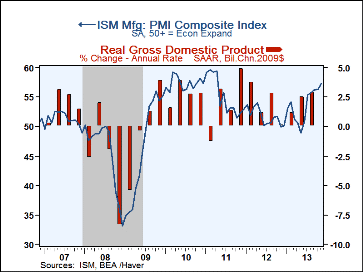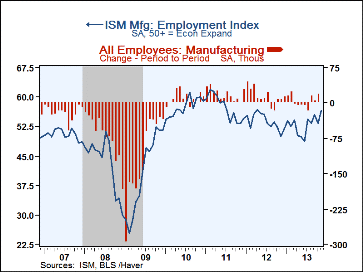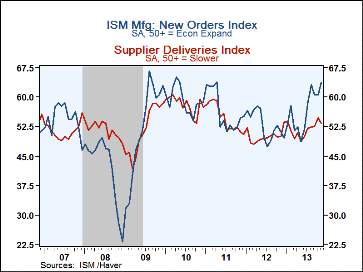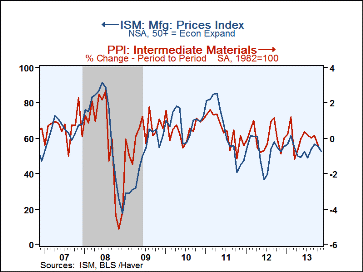 Global| Dec 02 2013
Global| Dec 02 2013U.S. ISM Index Shows Additional Factory Sector Improvement
by:Tom Moeller
|in:Economy in Brief
Summary
Activity in the manufacturing sector continued to firm last month. The Composite Index of Manufacturing Sector Activity from the Institute for Supply Management advanced to 57.3 during November from an unrevised 56.4 October reading. [...]
Activity in the manufacturing sector continued to firm last month. The Composite Index of Manufacturing Sector Activity from the Institute for Supply Management advanced to 57.3 during November from an unrevised 56.4 October reading. The latest reading was the highest level since April 2011. It beat expectations for a decline to 55.0, as measured by the Action Economics Survey. Any figure above 50 indicates an increasing level of activity in the factory sector. During the last ten years, there has been a 69% correlation between the ISM index and the q/q change in real GDP.
Improvement in hiring activity provided the greatest lift to last month's composite index. The factory sector employment series rose to 56.5, the highest level since April 2012. During the last ten years there has been an 88% correlation between the employment index and the m/m change in factory payrolls. The new orders index (63.6) gained with a jump in export orders while the production series (62.8) made up its October decline. To the downside were the inventories (50.5) and the supplier deliveries (53.2) indexes, the latter reversing much of its October indication of slower delivery speeds. The order backlog series increased to its highest level in nine months while the imports index slipped to the lowest level in six months.
The prices paid index series suggested easing pricing power as it backpedaled to its lowest level (52.5) since July. A lessened 18 percent of firms raised prices while a higher 13 percent lowered them. During the last ten years there has been a 67% correlation between the index and the m/m change in the intermediate producer price index.
The figures from the Institute For Supply Management (ISM) are diffusion indexes and can be found in Haver's USECON database. The expectations number is in the AS1REPNA database.
| ISM Mfg | Nov | Oct | Sep | Nov'12 | 2012 | 2011 | 2010 |
|---|---|---|---|---|---|---|---|
| Composite Index | 57.3 | 56.4 | 56.2 | 49.9 | 51.7 | 55.2 | 57.3 |
| New Orders | 63.6 | 60.6 | 60.5 | 51.1 | 52.9 | 56.4 | 59.2 |
| Production | 62.8 | 60.8 | 62.6 | 53.1 | 53.6 | 57.4 | 61.0 |
| Employment | 56.5 | 53.2 | 55.4 | 50.1 | 53.8 | 57.4 | 57.3 |
| Supplier Deliveries | 53.2 | 54.7 | 52.6 | 50.1 | 50.0 | 54.7 | 58.1 |
| Inventories | 50.5 | 52.5 | 50.0 | 45.0 | 48.2 | 50.1 | 50.8 |
| Prices Paid Index (NSA) | 52.5 | 55.5 | 56.5 | 52.5 | 53.2 | 65.2 | 68.9 |
Tom Moeller
AuthorMore in Author Profile »Prior to joining Haver Analytics in 2000, Mr. Moeller worked as the Economist at Chancellor Capital Management from 1985 to 1999. There, he developed comprehensive economic forecasts and interpreted economic data for equity and fixed income portfolio managers. Also at Chancellor, Mr. Moeller worked as an equity analyst and was responsible for researching and rating companies in the economically sensitive automobile and housing industries for investment in Chancellor’s equity portfolio. Prior to joining Chancellor, Mr. Moeller was an Economist at Citibank from 1979 to 1984. He also analyzed pricing behavior in the metals industry for the Council on Wage and Price Stability in Washington, D.C. In 1999, Mr. Moeller received the award for most accurate forecast from the Forecasters' Club of New York. From 1990 to 1992 he was President of the New York Association for Business Economists. Mr. Moeller earned an M.B.A. in Finance from Fordham University, where he graduated in 1987. He holds a Bachelor of Arts in Economics from George Washington University.










